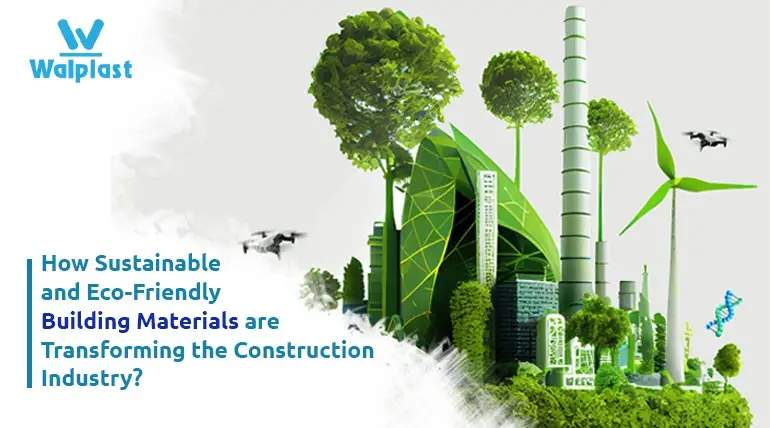
The construction industry is undergoing a significant transformation, driven by the increasing demand for sustainable and eco-friendly building materials. These materials are playing a crucial role in reducing the environmental impact of construction projects, promoting a circular economy, and ensuring that buildings are more energy-efficient and durable.
Sustainable building materials, such as recycled content and low-emission products, are designed to minimize waste and reduce the carbon footprint of construction activities. For example, products like HomeSure Waterproof Putty by Walplast contain 5% recycled materials and 10% recyclable content, supporting a circular economy by reusing materials that would otherwise end up in landfills. Similarly, HomeSure WallEx Self-curing plaster saves water and incorporates 5% recyclable waste and fly ash, further enhancing its environmental credentials. These innovations not only contribute to sustainability but also improve the overall performance and longevity of construction projects.
The Role of Advanced Materials in Modern Construction Projects
Advanced materials, such as self-healing concrete and aerogels, are revolutionizing modern construction projects by enhancing durability and energy efficiency. Self-healing concrete, for instance, can repair its own cracks, significantly reducing maintenance costs and extending the lifespan of structures. This innovative material addresses one of the most common issues in construction—cracking—thereby improving the structural integrity and safety of buildings.
Aerogels, known for their exceptional insulating properties, are another advanced material making waves in the construction industry. They provide superior thermal insulation, helping to reduce energy consumption in buildings. Although these materials generally come at a higher initial cost compared to traditional materials, their long-term benefits, including reduced maintenance costs and improved energy efficiency, often justify the investment. The integration of such materials represents a shift towards more robust and sustainable building practices.
Enhancing Functionality and Efficiency with Smart Materials and Technology
The integration of smart materials and technology in building materials is significantly enhancing the functionality and efficiency of contemporary structures. Smart materials, such as thermochromic and photochromic coatings, can respond to environmental changes by regulating indoor temperatures, thereby improving energy efficiency. These coatings can change colour or opacity in response to temperature or light, reducing the need for artificial heating and cooling.
Additionally, the use of sensors and embedded technology allows for real-time monitoring and maintenance of buildings, ensuring optimal performance and reducing operational costs. Innovations like these contribute to the development of intelligent structures that are more adaptable, sustainable, and user-friendly. Furthermore, technological advancements in the construction process, such as the automation of concrete pumps, MI shutters (aluminium), and 3D-printed concrete, streamline workflows and enhance overall efficiency.
The Impact of 3D Printing Technologies on Innovative Building Materials
3D printing technologies are profoundly influencing the development and application of innovative building materials in the construction sector. This technology, also known as additive manufacturing, constructs three-dimensional objects from CAD models through a layer-by-layer process. Large-scale 3D printers use construction-grade materials such as concrete and composites to create entire structures with remarkable efficiency and design flexibility.
The benefits of 3D printing in construction include significantly faster construction times, reduced material waste, and lower labour costs. It also allows for intricate and customized architectural designs that were previously difficult to achieve. Moreover, 3D printing supports sustainability by optimizing material usage and potentially incorporating eco-friendly materials. The ability to deploy 3D printers in remote or disaster-stricken areas for rapid construction further showcases its potential to revolutionize the industry.
Key Trends in the Use of Recycled and Repurposed Materials
The use of recycled and repurposed materials in construction is gaining momentum, driven by the need for environmental sustainability and the desire to reduce waste. Products like Walplast’s HomeSure Waterproof Putty and WallEx Self-curing plaster, which incorporate recycled raw materials and byproducts, exemplify this trend. These practices support a circular economy by reusing materials that would otherwise contribute to landfill waste.
Sustainable manufacturing processes, such as the use of renewable energy and eco-friendly materials like fly ash and slag cement, further enhance environmental sustainability. The industry is increasingly adopting these materials to reduce its environmental impact and promote more responsible waste management practices, reflecting a significant shift towards greener construction methods.
The Future of Prefabricated and Modular Construction
The shift towards prefabricated and modular construction is significantly influencing the demand for specific building materials and shaping future industry trends. Modular construction, which involves assembling buildings in a controlled factory environment, offers numerous advantages, including reduced construction time, lower costs, minimized site disturbances, and less waste. This method also mitigates weather-related delays, as a significant portion of the work is completed off-site.
The flexibility of modular buildings, which can be easily disassembled and relocated, reduces the need for new raw materials and energy consumption. As urbanization continues to drive demand for rapid and cost-effective construction solutions, modular construction is expected to become more prevalent, fostering innovation in building materials that are optimized for off-site fabrication and sustainable development.
Walplast’s Commitment to Sustainability
Under the leadership of Managing Director, Kaushal Mehta, Walplast is at the forefront of promoting sustainable and eco-friendly practices in the building and construction material industry. Our products, such as HomeSure Waterproof Putty and WallEx Self-curing Plaster, incorporate recycled materials and byproducts, supporting a circular economy. We prioritize the use of renewable energy and eco-friendly materials like manufactured sand, fly ash, and slag cement, ensuring our manufacturing processes are as sustainable as possible. Our commitment to sustainability not only enhances the environmental performance of our products but also sets a benchmark for the industry, leading the way towards a greener future in construction.
